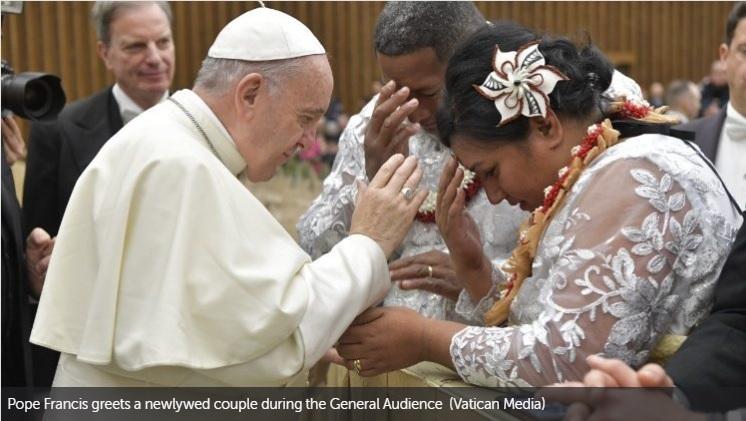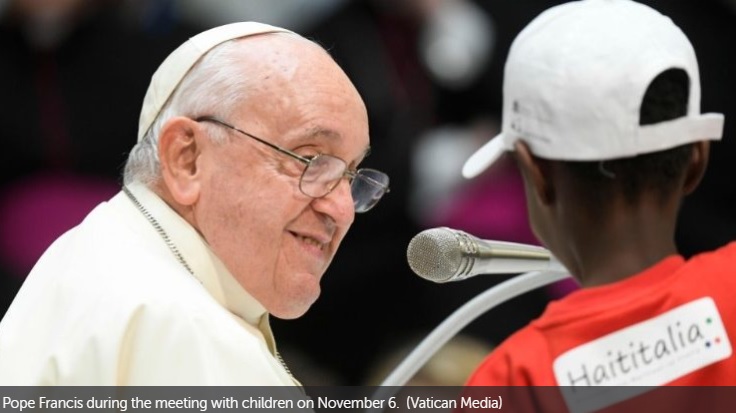
Pope’s Letter to Married Couples: the magisterium of a loving father
On the day following the publication of Pope Francis’ “Letter to Married Couples”, the Undersecretary of the Dicastery for the Laity, Family and Life reviews the “Amoris Laetitia Family Year” in preparation for the 2022 World Meeting of Families in Rome.
“A Christmas gift to you, newly married couples, an encouragement, a sign of nearness and an occasion for meditation.” This is how Pope Francis yesterday, on the feast day of the Holy Family of Nazareth, presented his Letter to Married Couples, a text that comes exactly one year after he announced the the “Amoris Laetitia Family Year” on December 27, 2020. It is a path that is rich in fruits and marked by the “tenderness of a father”, and as Gabriella Gambino, Undersecretary of the Dicastery for the Laity, Family and Life said, a tenderness that is renewed in a “magisterium text”:
In the Letter that he sent to newlyweds as a gift, Pope Francis goes through aspects and stages of family life, without forgetting young couples preparing for marriage, with the tone of a father. What strikes you about this message?
I am struck by the tenderness of the tone, the affection he expresses for families in such a complex time, that is still dominated by the pandemic. Today there are so many families experiencing crises and difficulties of all kinds, to whom the Pope turns his fatherly gaze. But I am particularly struck by the attention he pays to the Sacrament of Marriage. The beauty of this gift, so difficult for young people to understand today, lies in the presence of Christ, who dwells in families, in the midst of our daily lives. And with extraordinary delicacy, the Pope enters into our daily lives, into family dynamics, almost taking us by the hand to encourage us and make us not feel alone in this journey. And he exhorts young people to marry, to trust in the grace that invests spouses, a grace that sustains them throughout their lives in the adventure of marriage, even in the midst of storms. After all, the Pope reminds us that “in no way must the Church desist from proposing the full ideal of marriage, God’s plan in all its grandeur. Not to do so would be a lack of love on the part of the Church for young people. Understanding exceptional situations must never imply hiding the light of the fullest ideal, nor proposing less than what Jesus offers to human beings.” The Holy Father reminds us of this in Amoris Laetitia.” (AL 307)
The Letter to Married Couples comes exactly one year after the Pope announced the Amoris Laetitia Family Year on 27 December 2020 during the Angelus, five years from the publication of the Apostolic Exhortation. What do you think was set in motion by that announcement?
The pastoral care of families all over the world has been set in motion! In 5 years of reflections and doctrinal comparisons, we have taken action and our Dicastery, exhorted by the Holy Father, has been able to develop many pastoral tools to help dioceses and bishops’ conferences transform the Exhortation into action and pastoral creativity. Also in view of the World Meeting, which will take place in 6 months, this Letter of the Pope to married couples is a very important text of magisterium on the family, which parishes and dioceses will be able to use to prepare families for the Meeting, to reflect with families on what the family is and on how today, in the midst of so many difficulties. Therefore, I truly invite communities and parishes to read it and meditate on it in their homes, proposing it and distributing it to married couples all over the world.
In your opinion, what have been the most beautiful fruits of this year?
Without doubt, in general, I would say the many initiatives that the world is making known to our Dicastery, as well as all those that do not make it here, from the moment the Pope gave life to this impulse. So many parishes, dioceses, episcopal conferences, even schools and universities write to us to tell us what they are doing to respond to the Holy Father’s call: to accompany families, married couples, the most fragile situations, new unions, in which people are seeking the Lord. A process of pastoral creativity has been set in motion that is also leading to greater communion, in many contexts, between pastors and families, in order to learn to listen to each other and to give more value to the role of families and couples in the Church. It’s not easy, but everywhere you can perceive the desire to succeed, to try to understand how to walk together and also accompany the most difficult situations, those that were previously left a bit aside. Families are truly an asset for the Church, but in many contexts, we still need to understand how to put this statement into practice.
The Year dedicated to the family will end next June, with the celebration of the World Meeting of Families in Rome. Yesterday the Pope invited everyone to prepare well in order to live it well. How do preparations for this event, and the meeting itself, intertwine with the synodal path inaugurated by Pope Francis in the Church?
Amoris Laetitia, the scarlet thread that is leading us to the World Meeting, is asking us to be discerning in regards the style and the manner in which we carry out our pastoral service. A service the Holy Father is asking us to frame within the Church’s synodal journey through communion, participation and the mission of every single component of the People of God, including families. Pastors and families together, under the guidance of the Spirit. How to do it? It would be interesting, for example, during this synodal journey that is also a time of preparation for the World Meeting, to try to combine the process of ecclesial discernment starting also from the relationship between Church and family, asking ourselves questions that are a bit different from those we are used to. For example, ‘how can the family help the Church to be more synodal?’ ‘What can the Church learn from the family way of discerning, listening and welcoming?’ ‘What can the Church learn from the way parents, children, and siblings try to love each other with their frailties, vulnerabilities, conflicts, and different points of view?’ These, and other questions, could open up a new way of thinking about pastoral care, a different style, a more concrete communion between families and the Church. Not only that, but they would initiate a new process of discernment that, beyond the conclusion of the Family Year with the World Meeting, could continue at least until the Synod, continuing to stimulate family ministry throughout the world. – Gabriella Ceraso & Alessandro De Carolis
READ ALSO:
World Meeting of Families: A precious opportunity
Pope at Angelus: sustain, defend and safeguard the family
Pope to couples: God always with you in joys and difficulties of married life
SOURCE: Vatican News



This Post Has 0 Comments